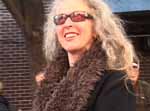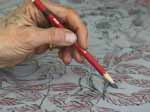


Vivien Bittencourt & Vincent Katz in Conversation about their film, Kiki Smith: Squatting The Palace, Checkerboard Films, Inc.
December, 2006
VK: Why did you want to do a video about Kiki Smith?
VB: I saw her works on paper show at MOMA Queens and was really surprised by how much I thought about it afterwards. A little later, you went to Kiki’s place to interview her for a Parkett article and came back amazed by her modus operandi, how she worked and lived in the same space, working constantly, in a circular way.
VK: But how do we choose someone about whom to do a video? There are so many fascinating people around.
VB: I love the way Kiki looks, her hair, the way she moves her hands. I liked the idea of shooting her working around, not interviewing her formally. Also, being around her work at her house, was very satisfying; I was always looking forward to visiting her and sharing what she was doing in that giving day, even not understanding how much could everything change so drastically in only one week period. Even the furniture would look different.
VK: Yes, I remember seeing a video of her working on a print at Universal Limited Art Editions in Long Island and thinking she was so photogenic! I still remember her saying, in that video, about the things she was trying, “They’re all for fun; it’s just for fun.” I found that so refreshing, that she could be doing what she does partially to entertain herself. I think if the artist is entertained, at least part of the public will be too. Kiki basically never stops working. Was it hard to catch her actions on camera? She moves very fast.
VB: It was hard to follow her around because she was always doing so many things at the same time! Thank god we had two cameras! She would be filing a gesso sculpture while deciding the next step of a book project and had the wax warming up in the stove and the telephone would ring and someone would be at the front door. Everything happening on two different floors. But instead of being frantic she would navigate the many duties kind of calmly. At the end of our shooting day, I had my doubts we had got any comprehensible footage. How about you?
VK: Well, I think our modus operandi has always been to follow artists and shoot whatever they happen to be doing, not setting up any artificial situations or “acts” for them. I believe that creates a more open film, in which the viewer can participate. When the filmmaking gets too narrative, in the sense of setting up the action in advance, or by adding narration later, the film becomes closed and a little lifeless. So, when you’re shooting in an open, less controlled way, you’re not sure what you’ve got at the end of the day. But you develop a way of shooting, and you trust that. Kiki was great, too, because she let us shoot whatever was going on in her house. She lives and works in a townhouse in the Lower East Side, and life and art co-exist. That was interesting to witness, although we were really after her art process, not so much the life-art interaction.
VB: The shooting took nearly two years to be completed with several visits to Kiki’s house. When did you feel we had it, it was time to stop and edit what we had?
VK: I really like to work on long-term projects. I feel like you pick a subject that interests you, start to follow it, and be patient. Eventually, if you pay close enough attention, the point of the story reveals itself to you. If you are unable to pay attention, are distracted, or are not patient enough, you may miss the point entirely. Two of my favorite documentary filmmakers are the Maysles brothers and Frederick Wiseman. They have in common that they are able to give themselves to the subject. In Kiki’s case, we waited and filmed, without knowing what was happening for a while. It was like being in a new environment, albeit a friendly one, a jungle or a club where we didn’t know the rules yet. So we just stayed there, shooting, following. Finally, the impetus of Kiki’s work began to be directed toward a major body of work that she was creating for an eight-room installation at the Fondazione Querini Stampalia in Venice, that would coincide with the 2005 Venice Biennale. Of course, we would have followed Kiki anywhere, but the fact that it was Italy was a perfect confluence with our own interests. So then, big new chapters presented themselves — the installation and exhibition of that work in Venice. Then I knew I wanted to interview Kiki one more time in New York, after the exhibition was over. In the meantime, Kiki’s mother, Jane Lawrence Smith, with whom Kiki was very, very close, passed away. We didn’t know if Kiki would want to talk about that, but we didn’t even have to ask her. As soon as the camera was on, and we began talking, she began talking about her mother, how she was so close to her that she still felt connected to her, even after death, that she had had an “optimistic” death. The great thing, I felt, was that after our shared experience together, it was more than a question of trust. It was more that the camera didn’t matter to her any more. We were just there talking. Then I knew we had it.
VB: How do you feel working in such small scale, like we do?
VK: For this kind of documentary, it’s the best way to go. Artists don’t like intrusion. They want to be able to keep going about their business, and, more than other people, they really don’t want the light changed! We do 99% of our shooting by natural light. We do a lot of hand held, though not for effect. We do it as steady as we can! We have to move in tight spaces and react quickly. It’s really traditional documentary technique, with newer, lighter cameras. I have a lot of respect for the people that filmed rock concerts in the ‘60s, for example, because they had to be very fast with heavy cameras. We’ve done most of our videos with only two people. This time, we were really lucky to have Tom Piper working with us. All three of us contributed camera work, which I think helps give the film a diversity of ways of looking, and Tom supervised the sound recording.
VB: We had many different editing versions, and different screenings. For me, I felt that the project unveiled itself when we were editing it — what Kiki had in mind a year or so before the show in Venice happened. Is that the case for you?
VK: I felt a sense of direction when we decided to make the film be about Venice. Before that, we had considered filming her retrospective tour, and we actually filmed other activities of hers that did not make it into the final film, since they did not have to do with Venice. But certainly, in the editing, we were able to find the ultimate shape and length the project would take. There’s always a feeling, before editing, that maybe we don’t have the “right” shots, that maybe we missed something. But editing is such a beautiful art — the combining of audio, music, the altering of sequences, the rhythms of the way one thing leads to the next — that is akin to the installation of an art exhibition. The film does not exist before it is made in the editing. How did the women’s issues in the Querini Stampalia work impact you?
VB: I liked the idea that Kiki was going to work with the imagery of women being the back bone of domestic life. But with a big twist! Kiki was thinking of the colonial American women “squatting” a Venetian palace, and it was so hard to realize how she would pull this off as an exhibition. Her images touch me historically, they touch me in different ways. I like Kiki’s mind; I like to see where she’s going, which is always difficult to predict. One thing I like about the film is that there is no “voice of authority” needed to legitimize Kiki’s work. Not only is there no omniscient narrator, there are also no interviews with critics or curators explaining what is significant about Kiki’s work. The people who speak, in addition to the artist, are people involved in the actual work with her.
Directed by VIVIEN BITTENCOURT & VINCENT KATZ
Edited by TOM PIPER
Color/45 minutes
© 2006 CHECKERBOARD FOUNDATION, INC.
New York, NY
Related Links:
Screenings: Film Forum
Book: DAP , Charta
About: Kiki Smith



